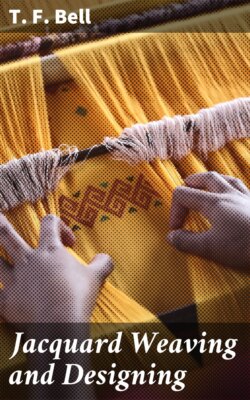Читать книгу Jacquard Weaving and Designing - T. F. Bell - Страница 9
На сайте Литреса книга снята с продажи.
FRENCH DRAW LOOM
ОглавлениеTable of Contents
Shortly after the introduction of Cross’s counterpoise harness, a machine was imported from France, which is shown in Fig. 14, and described in Murphy’s ‘Art of Weaving’ as a French draw loom. This machine far surpassed any attempts at the improvements at the draw loom that had hitherto appeared, in simplicity of construction and operation. From the neck upwards the harness is similar in construction to Cross’s counterpoise, having the knot cords arranged in the same manner, but with only one trap board. Instead of the cumbrous tail, the knot cords are acted upon by wires or needles, on each of which is a loop, through which one of the knot cords passes. D is the cylinder or barrel, perforated with holes, as in the common jacquard cylinder, and C, C shows the chain of cards for forming the pattern; E is the lever for raising the trap board, to which it is connected by means of pieces of iron at each side, with a bar across between them, to the centre of which the lever is connected with a piece of wire. O O are crossbars of wood, with holes in their centres, through which run pieces of strong iron wire, which are fixed into the trap board at each end to keep it steady while in operation. There is no spring box for the needles as is now used in the jacquard, but into the crossbar or frame F is inserted a flat piece of wood moving on springs, which yields to the pressure of the needles that are forced back by the barrel, and recovers them again when the barrel is withdrawn. The lever E is drawn down by the cord H, attached to a treadle, when the trap board is to be raised, and the barrel is drawn back by the cord G, which is attached to another treadle. The barrel is pressed against the needles by springs, and when it is relieved by the treadle and is moving inwards, it is turned by one of the catches shown in Fig. 14a. Either of these catches can be brought into action, so as to turn the barrel either way, by raising or lowering them with a cord. When at rest the knot cords stand in the notches or saw cuts of the trap board, but when the cards are pressed against the needles, except where there are holes in the cards, the needles are pressed back and the cords are pushed out of the notches so that the knots stand above the holes in the trap board, and pass through them when the board is raised by depressing the treadle connected with the lever E. The trap board is shown in Fig. 7.
Fig. 14
Fig. 14a
Whether this machine was Jacquard’s invention or not, I have not been able to ascertain; but Gilroy states that Jacquard’s first machines were made with cords and trap boards, like Cross’s counterpoise machine. It is also recorded that William Jennings, of Bethnal Green, invented a machine, similar to the above, about 1830, as an improvement on the jacquard, on account of its simplicity, as the latter appears to have given the weavers some trouble, and notice was taken of his machine by the Society of Arts.
Fig. 15
Machines similar to the above are still in use for hand-loom work, and answer very well. They have also been used for power looms, but the cords do not stand the friction long. As at present made about Glasgow, the cylinders of these machines work on slide rods, and receive their motion from the rising of the trap board, same as the cylinders in jacquards are sometimes wrought by the rising of the griffe with what is known as the ‘swan neck’ motion. The spring board at the ends of the needles is held back by a spring and drawn in by the cylinder frame as it moves outwards, which brings all the needles forward, and the cords into the saw cuts in the trap board, or comb as it is frequently called. The knots on the cords for these machines are made as at B, Fig. 15, which, when drawn tight, are as shown at A. The cord is a good twisted cord, such as whipcord, and the holes in the trapboard are about 3/16 in. in diameter, which the knots on the cords must pass freely through. The upper ends of the cords pass through a perforated board on the top of the machine, and another cord is drawn through loops on their ends, which prevents them from being drawn through the holes.
